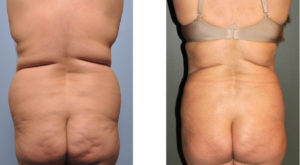
There are numerous misconceptions about the recovery process from liposuction for many patients. It is important to remember that despite the limited invasive appearance that appears on the outside the skin, substantial tissue trauma has occurred on the inside. The surface area of this tissue trauma is usually far greater than almost any other plastic surgery procedure. It does not really matter what technology is used, they all cause internal tissue damage.
While recovery can mean different things to different people, it is important to understand that there is no such thing as minimal or rapid recovery after liposuction…unless the amount of liposuction is very minimal. In reading many patient’s questions on different websites about liposuction recovery, substantial confusion exists about many facets of the process. They largely revolve around the issues of swelling and bruising, contour irregularities and shape, skin sensation, and physical activity after the procedure.
Swelling and some bruising is the sine que non of liposuction. With the substantial trauma under the skin, one can expect significant swelling. What I tell my patients is that when they take the wraps (compression garments) the next day, they are likely to see improvement already. This is due to the fat removal and the compression from the type of garments placed at the end of the surgery. However, not every patient will and just because they don’t doesn’t mean they never will. However, some if not all of this contour improvement will go away in the next several days after surgery which is normal. It usually takes two days after any surgery to see the maximal amount of inflammation and swelling enlargement.
The time course of this swelling and how long it will take to go away is always much longer than any patient thinks. Think of the swelling resolution as taking months, not weeks. This is because of the disruption of the lymphatics of the area treated, this takes a long time to resolve itself and allow the accumulated lymphatic fluids to clear. I tell my patients that we can critique the result at a minimum of three months after the procedure. This applies to any aspect of the contour seen, particularly lumps, bumps and irregularities. Any refinement of the result (high spots, low spots) should wait six months to be sure that the contour seen is the final result.

The feel of the tissues in liposuctioned areas will feel very firm and ‘lumpy’ for some time after surgery. This is part of the tissue swelling and obstructed lymphatics. The skin and underlying tissues will eventually soften but will take months to feel soft again. When the tissue site feels completely soft and pliable this is also the time to critique the result. This is when all of the swelling has finally gone away.
Since liposuction doesn’t involve making large incisions or requires any significant skin healing, early physical activity can not really stress the surgery site or affect healing. So one can return to work or exercise when one feels capable and comfortable. However, activity does drive lymphatic fluid and blood into the treated site which will be slow to get out. This results in an aggravation of the swelling. While one may want to get back to exercise as soon as possible, expect aggravation of swelling in the treated areas.
Dr. Barry Eppley
Indianapolis, Indiana


